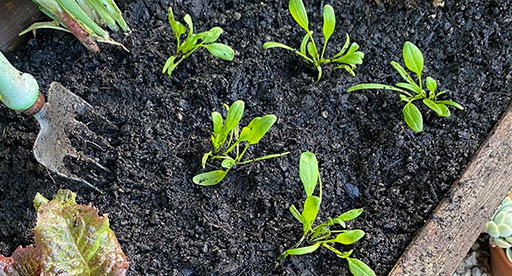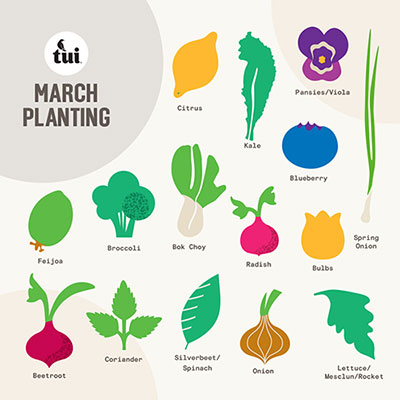
Autumn is here which means a new growing season.
March is a major harvesting period for both fruit and veges, and the perfect time to plant more for continuous harvests over the cooler months!
What to plant in March

Tui tips
- Take the time to replenish the soil and nutrients used over summer by digging in compost, Tui Sheep Pellets and Tui Vegetable Food.
- Remember if you are growing from seed to dry and save seeds of tomatoes, cucumbers, melons and beans, and store them in labelled envelopes ready for sowing next spring.
- Lay Tui Quash every few weeks to keep slugs and snails at bay.
- Add thick layers of Tui Mulch & Feed or Tui Pea Straw Mulch to garden beds and pots to conserve water, reduce weeds and add valuable nutrients back to the soil. Mulching also keeps your garden looking tidy and cared for!
In thE vegetable garden
- Carrots: thin rows of carrots to ensure the roots develop evenly, and to reduce the risk of attack by carrot rust fly.
- Lettuces: these can easily be grown through the cooler months; the red-leafed and cos types are the best to grow.
- Potatoes: dig up main crop potatoes when the tops begin to die down and wither. Store in sacks in a dry place with plenty of air movement and away from direct sunlight.
- Tomatoes: cut long, leafy stems back to encourage the fruit that has set on the bottom part of the plant to develop fully and ripen. It's unlikely that any flower appearing on the end of these stems will set fruit that will be able to ripen this season. Immediately remove any diseased leaves or fruit that may appear, to limit the spread of the problem.
In the fruit garden
- Pick apples, pears, grapes, Chilean guava, passionfruit, blueberries, strawberries, apricots, peaches, plums.
- Remove runners from strawberry plants and pot into Tui Strawberry Mix, ready for planting out in the winter.
- When planting fruit trees keep in mind that fruit requires a position in full sun and shelter from prevailing winds is preferable. Keep the soil moist and water fruit trees through dry periods.
- Aphids, whitefly, mites and scale insects may be about, blast off with a hose or select a suitable spray from your garden centre.
- Once nectarines, peaches and plums have finished fruiting, prune to shape and to remove any dead or diseased branches.
In the flower garden
- Bulbs: With autumn's arrival the widest variety of bulbs are now in-store, so it’s time to pick your bulbs to plant for a stunning spring show. As soon as the soil cools down, plant new bulbs or fertilise existing ones with Tui Bulb Food. Read our Bulb Growing Guide for more information.
- Roses: depending on how hot and dry the season has been is the last time to cut back roses to get another flush of flowers before winter.
- Pick dahlias, lilies, hydrangeas, cosmo, zinnia, rose, marguerite daisy, leucadendron, scabious, echinacea, strawflowers, gladiolus, sweet peas, gypsophila, cleome.
- Plant alyssum, gerbera, lobelia, polyanthus, flowering kale, primula, snapdragon, wildflowers, calendula, impatiens, marigold, pansy and viola, poppy, sweet pea, snapdragon, daisy, delphinium, dianthus, lavender, forget-me-not.
- Prune back perennials that have finished for the season.
Regional variaton: remember that there will be differences between crop timings depending on where you live, and the variety of vegetable grown. Always factor in climatic differences when sowing, planting and harvesting.
When should I plant
in
- Jan
- Feb
- Mar
- Apr
- May
- Jun
- Jul
- Aug
- Sep
- Oct
- Nov
- Dec
- Harvest in 2-3 years
Post a comment
March Garden Guide Comments
Be the first to write a comment